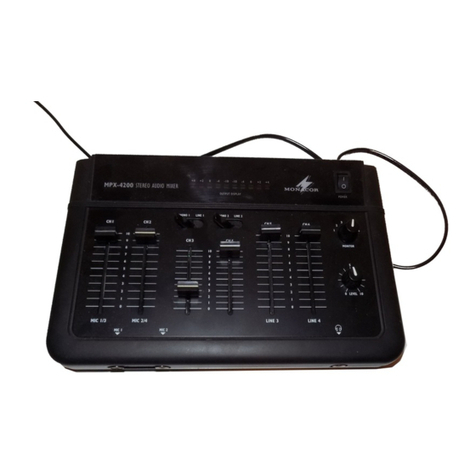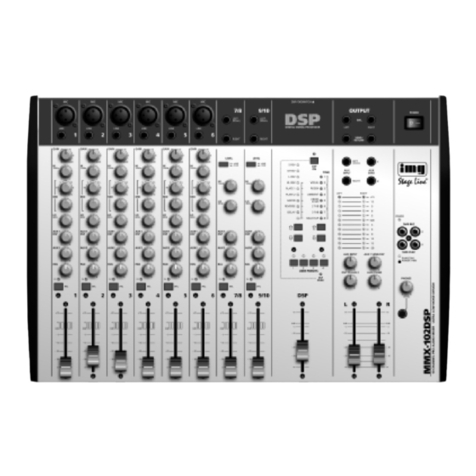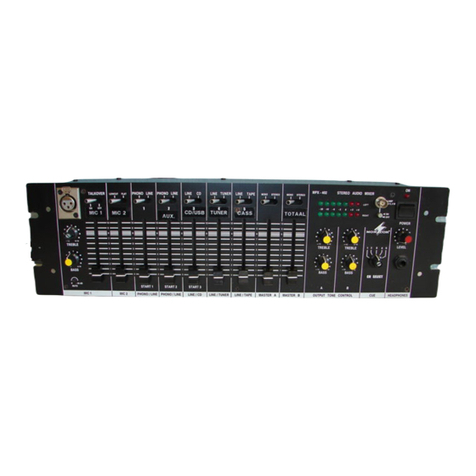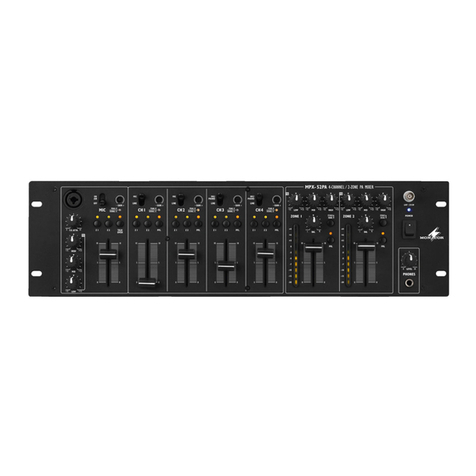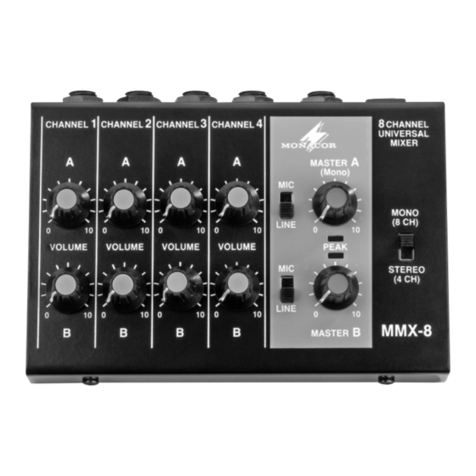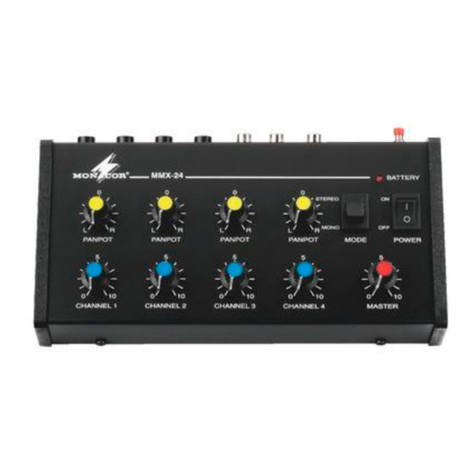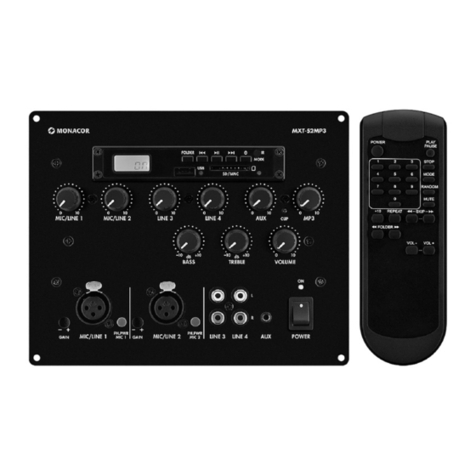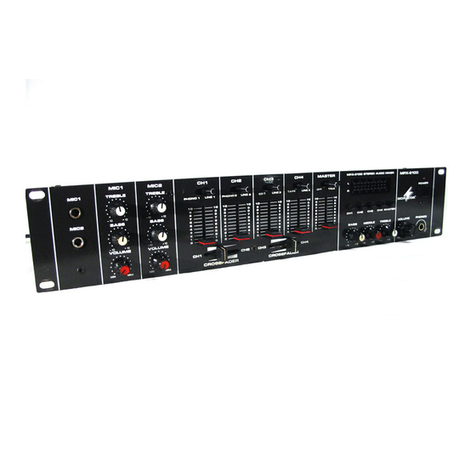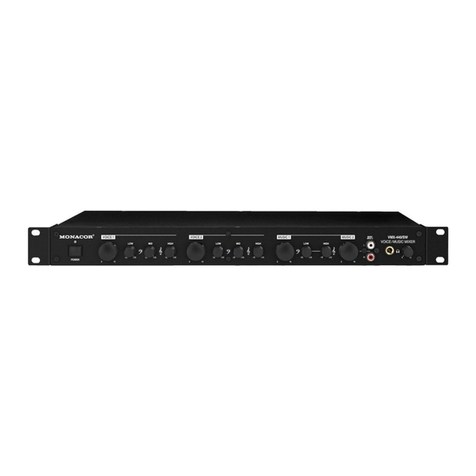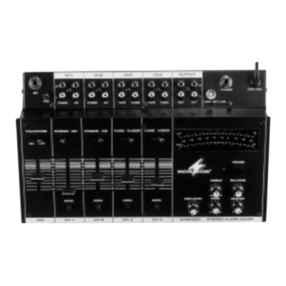Table de mixage stéréo
3 canaux
1Possibilités d’utilisation
Avec la MMX-3, trois appareils audio avec sortie Ligne
(par exemple lecteur CD, magnétophone, clavier) peu-
vent être mixés sur un canal master stéréo. Le canal
master peut être écouté via deux casques.
2Conseils d’utilisation et de sécurité
Les appareils (table de mixage et bloc secteur) répon-
dent à la norme européenne 89/336/CEE, relative à la
compatibilité électromagnétique. Le bloc secteur ré-
pond en plus à la directive 73/23/CEE sur les appareils
basse tension.
●Les appareils ne sont conçus que pour une utilisation
en intérieur. Protégez-les des projections d’eau et
éclaboussures, d’une humidité élevée et de la cha-
leur (plage de température de fonctionnement auto-
risée 0–40°C).
●Ne faites pas fonctionner la table de mixage et
débranchez le bloc secteur immédiatement dans les
cas suivants :
1. la table de mixage ou le bloc secteur présentent
des dommages visibles.
2. après une chute ou accident similaire, vous avez
un doute sur l’état de l’appareil.
3. des dysfonctionnements apparaissent.
Dans tous les cas, les dommages doivent être
réparés par un technicien spécialisé.
●Pour les nettoyer, utilisez uniquement un chiffon sec
etdoux, enaucun casde produitschimiquesoud’eau.
Attention!Leblocsecteurestalimentépar unetension
dangereuse 230V~. Ne touchez jamais l’intérieur de
l’appareil,vous pourriezsubirune déchargeélectrique.
●Nous déclinons toute responsabilité en cas de dom-
mages matériels ou corporels résultants si les
appareils sont utilisés dans un but autre que celui
pour lequel ils ont été conçus, s’ils ne sont pas cor-
rectement branchés, utilisés ou s’ils ne sont pas
réparés par une personne habilitée ; en outre, la
garantie deviendrait caduque.
●Lorsque les appareils sont définitivement retirés du
service, vous devez les déposer dans une usine de
recyclage adaptée pour contribuer à leur élimination
non polluante.
3Branchements
1) Reliez les appareils audio aux prises d’entrée INPUT
(7). Pour un appareil mono, ne reliez respectivement
quelaprise “L”. Le signal mono estainsiappliqué sur
les canaux droit et gauche.
2) Appliquez le signal master des prises MASTER
OUTPUT (8) sur l’entrée Ligne de l’appareil audio
suivant(par exemple tablede mixage, amplificateur).
3) Pour écouter le signal master, il est possible de relier
un casque respectivement aux deux prises HEAD-
PHONE OUTPUT (1).
4) Mettez la fiche basse tension du bloc secteur dans la
prise “12V ” (9) et reliez le bloc secteur à une prise
secteur 230V~/50Hz. La table de mixage est en
fonctionetle témoin defonctionnementvert (2) brille.
4Utilisation
1) Pour le réglage de base, tournez le réglage LEVEL
MASTER (4) et les réglages LEVEL PAN (6) sur la
position médiane. Les réglages PAN s’enclenchent
en position centrale.
2) Avec les réglages LEVELCH1 à CH3 (5), mixez les
signaux des appareils audio reliés ou faites-les en-
trer et sortir. Tournez les réglages des canaux inuti-
lisés entièrement vers la gauche sur le minimum.
3) Avec le réglage LEVELMASTER, adaptez le niveau
de sortie de la MMX-3 à l’appareil audio suivant.
4) Avec les réglages PAN, réglez la balance pour cha-
que canal séparément. Pour une source de signal
mono, le réglage correspondant sert de réglage de
panoramique pour placer le signal mono sur la base
stéréo.
5) Réglez le volume des casques reliés avec le réglage
HEADPHONE LEVEL (3).
6) Après le fonctionnement, débranchez le bloc secteur
de la prise secteur pour éviter toute consommation
inutile de courant.
5Caractéristiques techniques
Entrées : . . . . . . . . . . . . . 50mV, asym.
Sorties
1 x master : . . . . . . . . . 1V, asym.
2 x casque : . . . . . . . . . 11mW/32Ω
Bande passante : . . . . . . . 10–30000Hz
Taux de distorsion : . . . . . < 0,1%
Rapport signal/bruit : . . . . 63dB
Alimentation : . . . . . . . . . . 12V /150 mA par bloc
secteur livré branché à
230V~/50Hz/3VA
Température fonc. : . . . . . 0–40 °C
Dimensions, poids : . . . . . 147 x 111 x 49mm, 600g
D’après les données du constructeur.
Tout droit de modification réservé.
Attention! Ne réglez jamais le volume du casque
de manière très élevée. Un volume trop élevé peut,
à long terme, générer des troubles de l’audition.
L’oreille humaine s’habitue à des volumes élevés et
ne les perçoit plus comme tels au bout d’un certain
temps. Nous vous conseillons donc de régler le
volume et de ne plus le modifier.
Mixer stereo a 3 canali
1Possibilità d’impiego
Con il MMX-3 si possono miscelare tre apparecchi
audio con uscita Line (p.es. lettori CD, tape-deck, key-
board) su un canale stereo delle somme. Il canale delle
somme può essere ascoltato tramite due cuffie.
2Avvertenze di sicurezza
Gliapparecchi(mixer e alimentatore) sono conformialla
direttiva CE 89/336/CEE sulla compatibilità elettroma-
gnetica. L’alimentatore è conforme in più alla direttiva
73/23/CEE per apparecchi a bassa tensione.
●Far funzionare gli apparecchi solo all’interno di locali.
Proteggerli dall’acqua gocciolante e dagli spruzzi
d’acqua, da alta umidità dell’aria e dal calore (tempe-
ratura d’impiego ammessa fra 0 e 40°C).
●Non mettere in funzione il mixer o staccare subito
l’alimentatore dalla rete se:
1. il mixer o l’alimentatore presentano dei danni visi-
bili;
2. dopo una caduta o dopo eventi simili sussiste il
sospetto di un difetto;
3. gli apparecchi non funzionano correttamente.
Per la riparazione rivolgersi sempre ad un laboratorio
competente.
●Per la pulizia usare solo un panno morbido, asciutto;
non impiegare in nessun caso prodotti chimici o
acqua.
Attenzione! L’alimentatore funziona con tensione di
rete di 230V~. Non intervenire mai al suo interno; la
manipolazione scorretta può provocare delle scariche
pericolose.
●Nel caso d’uso improprio, di collegamenti sbagliati,
d’impiego scorretto o di riparazione non a regola
d’arte degli apparecchi, non si assume nessuna re-
sponsabilità per eventuali danni consequenziali a
persone o a cose e non si assume nessuna garanzia
per gli apparecchi.
●Se si desidera eliminare gli apparecchi definitiva-
mente, consegnari per lo smaltimento ad un’istitu-
zione locale per il riciclaggio.
3Eseguire i collegamenti
1) Collegare gli apparecchi audio con le prese d’in-
gresso INPUT (7). Nel caso di un apparecchio mono,
collegaresolo la presa“L”. In questomodo, il segnale
monoviene fatto passare sulcanalesinistro e destro.
2) Portare il segnale delle somme delle prese MASTER
OUTPUT (8) sull’ingresso Line dell’apparecchio
audio a valle (p.es. mixer, amplificatore).
3) Per ascoltare il segnale delle somme, alle due prese
HEADPHONE OUTPUT (1) si può collegare a cias-
cuna una cuffia.
4)Inserire la spina per alimentazione DC dell’alimenta-
tore nella presa “12V ” (9) e inserire l’alimentatore
stesso in una presa di rete (230V~/50Hz). Il mixer è
ora in funzione e la spia verde di funzionamento (2)
rimane accesa.
4Funzionamento
1) Come impostazione base, portare i regolatori LEVEL
MASTER (4) e LEVEL PAN (6) in posizione centrale.
I regolatori PAN si fermano con uno scatto al centro.
2) Con i regolatori LEVEL CH1 a CH3 (5) si miscelano
osiinserisconoodisinseriscono i segnali degli appa-
recchi audio collegati. Spostare tutto a sinistro, sul
minimo, i regolatori dei canali non utilizzati.
3) Adattare il livello d’uscita del MMX-3 all’apparecchio
audio a valle, servendosi del regolatore LEVEL
MASTER.
4) Con i regolatori PAN si imposta il bilanciamento
separatamente per ogni canale. Nel caso di una sor-
gente mono, il relativo regolatore serve come panpot
per posizionare il segnale mono nella base stereo.
5) Impostare il volume delle cuffie collegate con il rego-
latore HEADPHONE LEVEL (3).
6) Dopo l’uso, staccare l’alimentatore dalla rete per non
consumare della corrente inutilmente.
5Dati tecnici
Ingressi: . . . . . . . . . . . . . . 50 mV, asimm.
Uscite
1 x master: . . . . . . . . . 1V, asimm.
2 x cuffia: . . . . . . . . . . . 11mW/32Ω
Gamma di frequenze: . . . 10–30000Hz
Fattore di distorsione: . . . < 0,1%
Rapporto S/R: . . . . . . . . . 63 dB
Alimentazione: . . . . . . . . . 12 V /150mA tramite ali-
mentatore 230V~/50Hz/
3VAin dotazione
Temperatura d’esercizio: . 0–40°C
Dimensioni, peso: . . . . . . 147 x 111 x 49mm, 600g
Dati forniti dal produttore.
Con riserva di modifiche tecniche.
Attenzione! Mai tenere molto alto il volume nelle
cuffie.Alungo andare, il volume eccessivo può pro-
curare danni all’udito! L’orecchio si abitua agli alti
volumi e dopo un certo tempo non se ne rende più
conto. Non aumentare il volume successivamente.
I
MMX-3
Best.-Nr. 24.3780
wwwwww..iimmggssttaaggeelliinnee..ccoomm
Copyright©by MONACOR INTERNATIONAL GmbH & Co. KG, Bremen, Germany. All rights reserved. A-0287.99.01.08.2004
®
